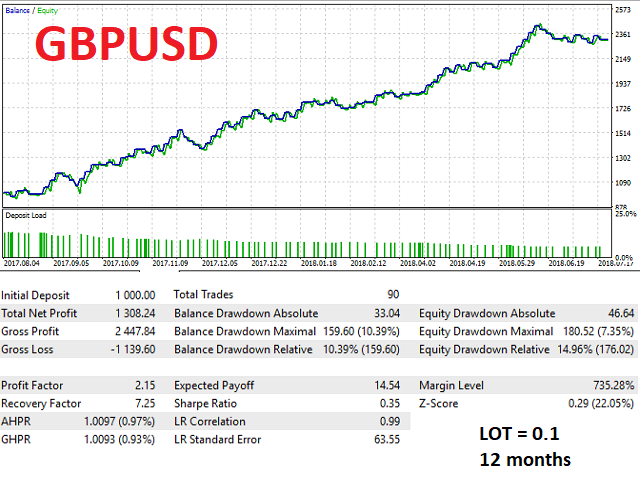Basic:
- Not a martingale, not a networker, works on all pairs;
- It is based on a good rational algorithm;
- Work on the interaction of two indicators: RSI (from the higher timeframe – works as a signal filter) and RSI (from the lower timeframe – works as a signal);
- There is a good money management system (there are several options for trailing stop loss);
- It is possible to work on closed candles, and on current candles;
- It is quickly optimized (the work is accelerated as much as possible).
- The actual sets after optimization are under discussion.
- Not a martingale, not a networker, works on all pairs;
- It is based on a good rational algorithm;
- Work on the interaction of two indicators: RSI (from the higher timeframe – works as a signal filter) and RSI (from the lower timeframe – works as a signal);
- There is a good money management system (there are several options for trailing stop loss);
- It is possible to work on closed candles, and on current candles;
- It is quickly optimized (the work is accelerated as much as possible).
- The actual sets after optimization are under discussion.
For those who want to optimize themselves, a large algorithm has been implemented for advanced optimization according to the “User criterion”. There are a number of limiting parameters (described below in the Parameters section), and if the values of the current pass are below the minimum parameter, then the result of this pass becomes negative, which has a good effect on the Genetic Algorithm
MetaTrader 4:
MetaTrader 5:
[spoiler title=”Read More…”]
For those who want to optimize themselves, a large algorithm has been implemented for advanced optimization according to the “User criterion”. There are a number of limiting parameters (described below in the Parameters section), and if the values of the current pass are below the minimum parameter, then the result of this pass becomes negative, which has a good effect on the Genetic Algorithm
MetaTrader 4:
MetaTrader 5:
MetaTrader 4:
MetaTrader 5:
parameters:
Slippage – the size of the slip;
NEED_LOGS – responsible for the output of logs to the terminal;
RSI_TF is a variant of the RSI (junior) and RSI (junior) timeframes
Parameters of the RSI(relative strength index) indicator from the older timeframe:
RSI_UP_Period – period of the RSI indicator;
RSI_UP_price – the price type of the RSI indicator;
RSI_UP_level_buy_out – the overbought level of the RSI indicator;
RSI_UP_level_sell_out – the oversold level of the RSI indicator;
Parameters of the RSI(relative strength index) indicator from the lower time frame:
RSI_LOW_Period – period of the RSI indicator;
RSI_LOW_price – the price type of the RSI indicator;
RSI_LOW_level_buy_out – the overbought level of the RSI indicator;
RSI_LOW_level_sell_out – the oversold level of the RSI indicator;
num_of_bar_for_analize – the number of the investigated bar (candle). Value – 0 – search for signals at current prices (significantly slows down optimization);
Money management parameters:
MM_trailing_type – Money Management type. Options: TYPE_MM_NON_MM (without TP and SL); TYPE_MM_JUST_SL (only SL); TYPE_MM_TRAILING (trailing stop loss and TP); TYPE_MM_SL_TO_0 (SL trails only to the breakeven price);
MM_TP_pips – TakeProfit size (in pips);
MM_TRSL_pips – Trailing StopLoss size (in pips);
MM_SL_pips – StopLoss size (in pips);
MM_magic_num – magic number for transactions;
MM_close_deal_when_opposite – permission to close the current position and open a new one in the opposite direction when a signal appears;
MM_lot – lot size;
MM_type_of_risk – “Fix_lot” deals are opened with a fixed volume specified in the “mm_lot” parameter. “Smart_lot_by_risk” volume is calculated dynamically, “mm_risk_percent” – max risk.
Optimization parameters according to the “User Criterion” (for advanced users):
CUSTOM_MAX_min_trades_per_month – minimum number of transactions per month (on average);
CUSTOM_MAX_min_EXPECTED_PAYOFF – minimum expectation of winning;
CUSTOM_MAX_min_PROFIT – minimum profit;
CUSTOM_MAX_max_EQUITY_DD_percent – maximum drawdown percentage;
CUSTOM_MAX_min_PROFIT_FACTOR – minimum profitability;
CUSTOM_MAX_min_RECOVERY_FACTOR – minimum recovery factor;
CUSTOM_MAX_check_profit_every_month – check once a month (to speed up optimization). If the check is not passed, then this optimization pass is stopped, and the result is assigned the value “-100”. There are options: do_not_check (do not perform this check); without_loss_months (all months in profit); max_1_loss_month (maximum 1 unprofitable month in a row); max_10_percent_loss_in_month (maximum 10 percent loss per month); no_max_DD (balance at the end of the month at least CUSTOM_MAX_max_EQUITY_DD_percent of the maximum balance for the entire period);
CUSTOM_MAX_return – what to return in the optimization results. Options: the entire standard set of the terminal; My_Formula (a complex formula found on the Internet); PROM (Pessimistic margin yield – from Robert Pardo’s book); Balance_x_minDrawdown_x_TradesNumber; Balance_x_minDrawdown_x_ProfitFactor; Balance_x_minDrawdown_x_ProfitFactor_x_SharpeRatio.
[/spoiler]





